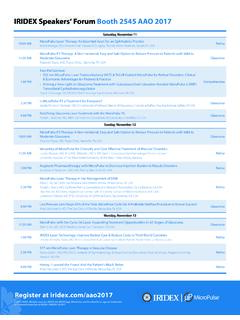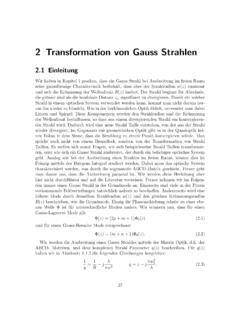Transcription of COVER STORY: LASERS ALT, MLT, SLT - IRIDEX
1 MARCH 2009 IGLAUCOMA TODAYI 43 laser trabeculoplasty has played a significant role inthe treatment of open-angle glaucoma for thepast several decades. The procedure was originallyperformed with the argon laser , but several otherwavelengths have now been used and shown to be effec-tive for this application. Recently, different technologieshave been developed in an attempt to maintain laser tra-beculoplasty s efficacy while minimizing its side article compares argon laser trabeculoplasty (ALT),selective laser trabeculoplasty (SLT), and multipulse lasertrabeculoplasty (MLT). WAVELENGTHTo determine the relative impact of any new laser tech-nology on biologic tissue, it is worthwhile to review thelaser/tissue interactions that occur. With laser trabeculo-plasty of all types, the chromophore or target is melanin,which absorbs visible light very well especially the greenlight with a wavelength of 532 nm used in SLT. Argonlasers emit light in the green and blue-green range, whichis also well absorbed by melanin.
2 In recent years, double-frequency Nd:YAG LASERS have slowly replaced traditionalargon LASERS for ALT, but the principles of the procedureare the same. These solid-state LASERS are generally moreportable and less expensive to operate than traditionalgas LASERS . MLT uses a longer wavelength of 810 nm,which is generated by a diode laser . Because this wave-length is not as efficiently absorbed by melanin as theshorter visible wavelengths of light, it typically penetratestissue more SIZE AND ENERGYThe spot size is 50 m in ALT, 400 m in SLT, and 300 min MLT. The difference in spot size influences how muchirradiance or energy per square area is applied to the tra-becular meshwork. SLT generally uses energies of approxi-mately to mJ per pulse compared with 40 to 70 mJper pulse for ALT and mJ per pulse for OF TREATMENTThe greatest difference between ALT, SLT, and MLT is theamount of time that laser energy is applied to the trabecu-lar meshwork.
3 In ALT, the pulse duration is usually sec-onds versus 3 nanoseconds in SLT. For MLT, the typical pulseduration is seconds divided into 100-microsecond pulsesat a duty cycle of 15%. The pulse duration has a significantimpact on the type of laser /tissue interaction that occurswith each application of laser exposure to laser energy in the range of that used inALT, melanin absorbs the light energy and converts it intoheat, which in turn creates thermal damage with subse-quent coagulative necrosis. The amount of damage is notlimited to the treatment area but extends beyond the tra-becular cells that contain melanin. The trabecular beamsand other extracellular tissues sustain significant damage. In SLT, the pulse duration is shorter than the thermalrelaxation time of biologic tissue. Although the melaningranules within trabecular cells absorb the laser energy,there is no heating of adjacent tissues. As a result, thedamage to the pigment-containing trabecular cells is lim-ited, and the trabecular beams sustain no permanentstructural damage, as occurs during ALT.
4 MLT uses a train of low-irradiance 300-microsecondlaser pulses that theoretically thermally affect but do notdestroy pigmented cells in the trabecular the application of the laser energy on and offminimizes the rise in temperature in the treated way, the tissue is able to cool off while the energyapplication is off. In theory, MLT generates enough ther-mal energy to injure but not destroy OF ACTIONR egardless of the physics of each laser used for tra-beculoplasty, a common pathway of events appears tooccur to reduce the IOP. The pressure seems to decreasenot due to a drilling of drainage channels or contractionof tissue, but rather due to an increase in the meshwork spermeability and the resultant rise in outflow. After lasertrabeculoplasty, there appears to be an immediate re-lease of cytokines followed by monocytic recruitmentthat facilitate greater ,2 Based on this information, the damage to tissue thatoccurs during ALT and trabeculoplasty with other lasersusing longer pulse durations appears to constitute anunnecessary overtreatment.
5 That is, the damage thatoccurs to structures such as the trabecular beams doesWhat does it matter?BY ROBERT J. NOECKER, MD, MBAA LT, M LT, S LTCOVER story : LASERSnot seem necessary to generating the common pathwayresponse of cytokine release and monocytic activationand recruitment. The clinically observable IOP-loweringeffect is comparable among the various techniques oflaser trabeculoplasty in the short term, whether or notthat technique causes structural damage. EFFICACYTh e G l a u co m a L a s e r Tre a t m e n t Tr i a l e s t a b l i s h e d t h e e f f i -cacy of laser trabeculoplasty. This prospective study com-pared the use of ALT and medical therapy for the treatmentof glaucoma. Two hundred seventy-one patients with previ-ously untreated primary open-angle glaucoma were ran-domized to ALT or medication. Through a 2-year follow-upperiod, the eyes treated with ALT had a lower mean IOPthan those treated with medication, and 25% of those ALT-treated eyes did not require medical treatment.
6 At 7 years,in 203 of the original 271 patients, ALT-treated eyes had onaverage a lower IOP, better visual fields, and a better opticdisc status than eyes in the medication Glauco-ma laser Treatment Trial had limitations such as random-ization by eye rather than individual, an antiquated medicaltreatment regimen, a small sample size, a heterogeneousearly glaucoma population, and the fact that most of thepatients treated with ALT ended up requiring medications. SLT was developed in the 1990s as an alternative to ALTand traditional laser trabeculoplasty. SLT seems to lowerIOP comparably to ALT without coagulative past decade, numerous articles have demonstratedthe efficacy and safety of SLT. One of the first studies byLatina et al showed that SLT was efficacious in patients onmaximally tolerated medical therapy in whom prior lasertrabeculoplasty had studies haveshown SLT to be efficacious in previously untreated pa-tients as et al showed similar levels of IOPlowering between SLT and ALT over 1 more recently introduced technology, MLT uses a dif-ferent strategy than SLT to reduce the amount of energythat is delivered to the trabecular meshwork.
7 Clinically, thereis less information available about MLT than either SLT orALT. Small short-term studies8and anecdotal reports showthat MLT lowers IOP comparably to the other competingtechniques. Yet to be confirmed are the theoretical advan-tages of a lesser thermal effect than ALT that MLT The decrease in IOP that laser trabeculoplasty canachieve seems to be similar with all of the available tech-nologies. The differentiating factors between ALT, SLT, andMLT are the collateral damage and the incidence of sideeffects with each technique. Clinically, the most commonside effects observed with laser trabeculoplasty are IOPspikes and anterior segment inflammation. The latter tendsto be lesser with SLT, and anti-inflammatory medications arenot used after this procedure. The one complication thathas been reported with ALT but not SLT or MLT is the for-mation of peripheral anterior synechiae. This differencespeaks to the thermal nature of ALT compared with SLT andperhaps MLT.
8 ALT also tends to be more uncomfortable tothe average patient than SLT during the seems that any thermal effects that extend beyond thecellular level are undesirable and can lead to decreased clin-ical safety in the form of IOP spikes, the formation ofperipheral anterior synechiae, and inflammation. The inci-dence of IOP spikes varies significantly due to differences inthe populations and treatment parameters, but the rate ofthis complication appears to be lower with SLT than the use of preoperative medications to decreasethe incidence of IOP spikes is effective with any type of tra-beculoplasty, the rate of untreated IOP spikes tends to belower with SLT and MLT compared with ALT. Studies havereported a 30% incidence of elevations in IOP greater than5 mm Hg with ALT, an incidence of less than 10% with SLT,and only one eye in the MLT ophthalmologists continue to use laser trabeculo-plasty earlier in the treatment algorithm for glaucoma,these factors may become increasingly important.
9 Robert J. Noecker, MD, MBA, is the director ofthe Glaucoma Service and an associate professor/vice chair at the Department of Ophthalmologyat the University of Pittsburgh. He has receivedresearch funds from IRIDEX Corporation andLumenis Inc. within the past 2 years. Dr. Noecker may bereached at (412) 647-5753; Samples J. Effect of wavelengths on trabecular cell division after laser trabeculoplasty[Abstract 1673]. Invest Ophthal Vis Sci. 1990;31(4). 2. Alvarado JA, Alvarado RG, Yeh RF, et al. A new insight into the cellular regulation of aque-ous outflow: how trabecular meshwork endothelial cells drive a mechanism that regulates thepermeability of Schlemm s canal endothelial cells. Br J Ophthalmol. 2005;89(11) Glaucoma laser Trial Research Group. The Glaucoma laser Trial (GLT) and GlaucomaLaser Trial Follow-up Study: 7. Results. Am J Ophthalmol. 1995;120(6) Kramer TR, Noecker RJ. Comparison of the morphologic changes after selective laser tra-beculoplasty and argon laser trabeculoplasty in human eye bank eyes.
10 ;108(4) Latina MA, Sibavan SA, Shin DH, et al. Q-switched 532-nm Nd:YAG laser trabeculoplasty(selective laser trabeculoplasty): a multicenter, pilot, clinical study. ;105(11):2082-2088; discussion Melamed S, Ben Simon GJ, Levkovitch-Verbin H. Selective laser trabeculoplasty as pri-mary treatment for open-angle glaucoma: a prospective, nonrandomized pilot study. ArchOphthalmol. 2003;121(7) Damji KF, Bovell AM, Hodge WG, et al. Selective laser trabeculoplasty versus argon lasertrabeculoplasty: results from a 1-year randomised clinical trial. Br J ;90 Detry-Morel M, Muschart F, Pourjavan S. Micropulse diode laser (810 nm) versus argonlaser trabeculoplasty in the treatment of open-angle glaucoma: comparative short-term safetyand efficacy profile. Bull Soc Belge Ophthalmol. 2008;308 Lanzetta P, Menchini U, Virgili G. Immediate intraocular pressure response to selectivelaser trabeculoplasty. Br J Ophthalmol. 1999;83(1) Ma YR, Lee BH, Yang KJ, Park YG.



